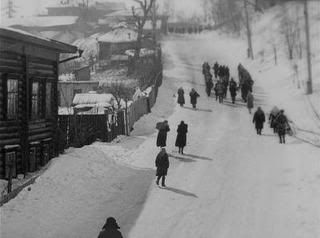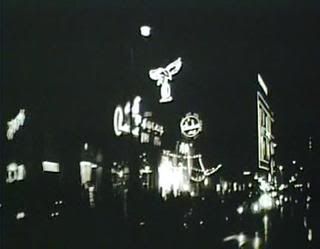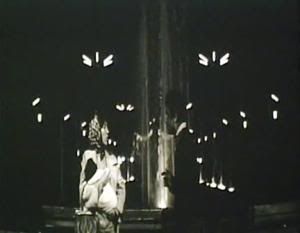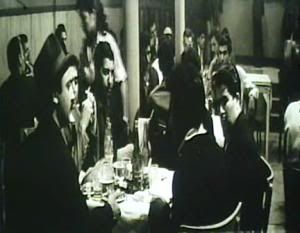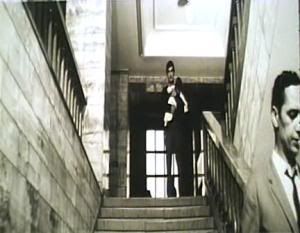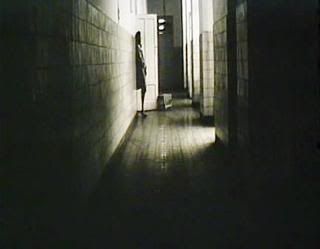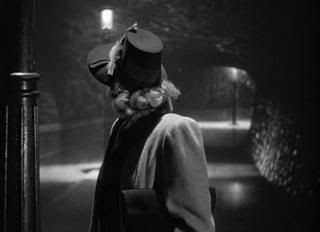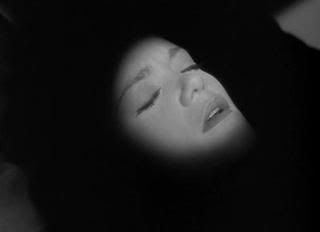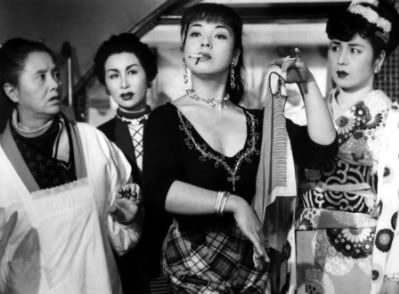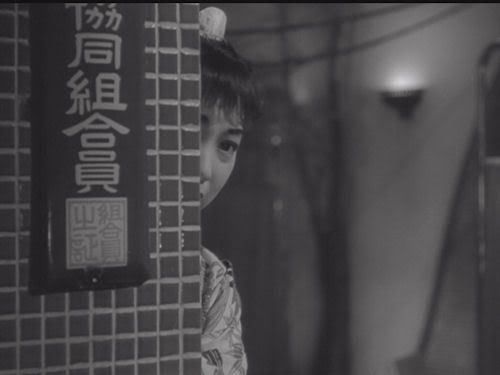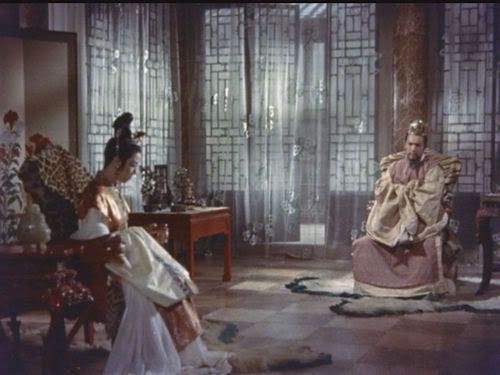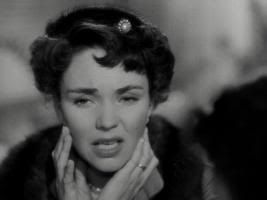Writer's Note: Do
NOT under any circumstances read my thoughts if you haven't seen the film!
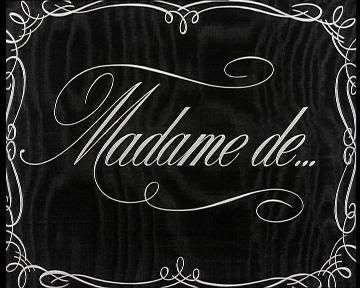
The filmography of Max Ophuls arguably lends itself better than most to the
auteur theory. It's an oeuvre that mirrors its creator's national displacement - he made films in five different countries - but despite the personal upheavals, Ophuls nevertheless managed to spend almost a quarter of a century redefining and then refining the art of the cinematic romance. The language of his dialogue may be dependent upon location, but the director's
film language is a constant that remains instantly recognizable: the glistening surfaces of his sets; the meticulously choreographed camerawork; the motifs of movement that support his enactments of desire in motion; the dominance of the dance and the duel; and the melodramatic yet evocative compositions that painfully underscore the naked heart of his cinema. The circular and cyclical structure of the director's biggest popular hit,
La Ronde (1950), can well be applied to the entire output of a career that finds him reusing and remoulding themes, symbols and even entire scenes in order to augment the sense of predetermination that intrigues so many of his characters. Bearing his particular concern with European history in mind (a turn-of-the-20th-century backdrop informs many of his most acclaimed works), it is perhaps fitting that Ophuls's own cinematic past should so invariably inform his present.
His penultimate achievement,
Madame de..., represents the culmination of this creative phenomena. Not only does it bear the auteurial stamps that were cited earlier, but it also draws from his preceding efforts in a manner that identifies the film as
the pinnacle of his craftsmanship - eventually attaining a type of postmodern singularity by means of its plurality. Although not strictly necessary, a basic comprehension of the cinematic roundabout that is Ophuls's oeuvre deepens the subtleties of
Madame de..., whilst concurrently accentuating the passions that enflame its core. Here lies the circularity of
La Ronde, the masochism of
Letter from an Unknown Woman, the stylistic excesses of
Le Plaisir, the historical evocations of
De Mayerling à Sarajevo. Note also: the pre-eminence of a single object; the obligatory train station scenes; the centrality of an opera house; the inescapable presence of the military. All of these traits persistently manifest themselves throughout the director's work, but nowhere do they coalesce within a single film as supremely as they do here. Appropriately,
Madame de...'s inevitable conclusion operates on a dual front: through the strength of Ophuls’s storytelling; and via the weight of the director's past tales. The final, definitive action of the film and the events that lead up to it suggest that it is not simply Louise, the General and Donati who are entangled within these hands of fate. Their love triangle is the final and greatest entry in a star-crossed line that stretches back over two decades, encompassing: Lisa and Stefan from
Letter; Sophie and Franz from
Mayerling; and, most directly, Christine and Fritz from
Liebelei. Each lover’s failure to transcend their physical milieu is glaringly exposed by this director’s ability to figuratively traverse space and time with such enviable ease.
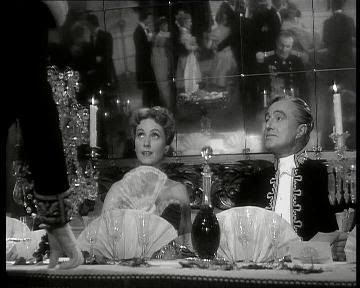
Valid discussions of Ophuls’s career are of course impossible if one bypasses the role of women in his work. The director’s feminist credentials can well be debated (are women not merely the most accessible and arguably effective tools with which to examine the more pertinent matter of love and its relationship to the social order?), but his consistent alignment with female characters cannot. 1934's
La Signora di tutti receives numerous citations as the film where the mobile,
Ophulsian camera of the 1950s first rears its head. Yet it remains equally significant for the development of its female-driven narrative, whose deconstruction of celebrity provides early prep work for 1955's more renowned
Lola Montès.
Signora's muddled interspersion of gaiety and tragedy struggles to locate the harmonious equilibrium of later films, but the presence of the ultimately sympathetic female protagonist is crucial. In so many of Ophuls's narratives conflict emanates from a woman's heart, and
Signora illustrates this at its earliest stage. Feminine desire is forever engaged in a battle against the social order, and the dramatic friction caused by two such powerful, vital forces spills over into the everyday - a woman's revolt against society becomes an urgent struggle against other individuals and the self. By 1953, Ophuls excels in the transmission of such concerns, and thus the fractured characterizations and overt sensationalism that undermine
Signora's tragic undercurrents are replaced with the intricately-drawn participants of
Madame de...'s ill-fated love triangle, here supplemented by a melodramatic framework that magnifies the tragedy by unearthing its nuances instead of encouraging its histrionics.
One can also find a unique sense of bliss in the director’s image-conjuring prowess.
Madame de...'s entrancing presentation of the Parisian Belle Époque is emblematic of his later films' expertise in realizing success on a base, though nonetheless intoxicating plane where luxurious artifice equates to unabashed viewing pleasure. And yet for many casual observers, Ophuls's visual flair either belies the integrity of his sentimental scenarios, or predicates a taste for surface sheen over narrative substance. To side with such charges however, is to ignore the acumen with which the director executes his magisterial vision. In
Madame de... every track, every pan, every prop and every ray of light contribute to a suave exercise in cinematic deception. To borrow a prominent example, the trademark fluidity of Ophuls's camerawork embodies an interfilmic binary opposition through its ability to impart both liberation (acting as a spiritual extension that provides temporary release from the corporeal), as well as incarceration (by defining the parameters of this escape), all the while veiling its intents behind a shroud of dignified hyperactivity. A camera that is as happy to waltz with its subjects as it is to magically glide through walls understandably poses a threat to a hardened aesthete's resistance - but the illusory experience on offer in
Madame de... is just that: a mask that disguises the camera's active participation in content as well as style.
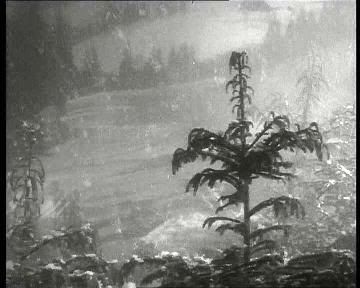
Concealed depths such as these are not just restricted to traditionally stylistic devices. A series of ironies and evasions perfuse the dialogue also, thus revealing the chasm between the characters' self-constructed exteriors and the realities of their internal yearning. Throughout their courtship, Louise insists to Donati:
"I do not love you"; although neither lover nor audience believes this proclamation for a second, with the conspicuous lie betraying an antithetical truth. One of the heated encounters during the film's final act finds the General falsely accusing Donati of calling
"the army, and consequently its generals... useless!" Donati says no such thing, but admits to the crime as a penance for his forbidden love - a topic that cannot enter the forum of public debate. And early on in the film, Louise and the General participate in a delicious tête à tête regarding the earrings' whereabouts. Their shared rapport is attractively transparent during verbal exchanges where the audience is privileged with the knowledge that both parties are deliberately suppressing their awareness of the truth to win greater gain from their significant other. Yet even in a comedic encounter that radiates as much warmth as this, narrative and visual style work in unison to intensify the film’s emotional canvas. Despite reinforcing the pair’s companionship with a sequence of shot/reverse-shots in close-up from their respective beds, the director employs an 180˚ pan to precede the sequence and two long-shots to conclude it, both sharing the same purpose: to divulge the startling distance between the sleeping quarters in question. Charm, vivacity and mutual affection may characterize the
tone of this scene, but Ophuls typically ensures that it is a somewhat dispiriting lack of romance which the viewer is ultimately left to ponder.
Tellingly, marital vows in
Madame de… are not far removed from those in other Ophuls pictures.
Liebelei,
La Ronde and
Le Plaisir all to some degree depict the carefree attitudes with which certain partners treat their prescriptions of monogamy.
Madame de…’s thorough exploration of frivolity’s limitations - which eventually unravel its characters’ pretences - allows it to differentiate itself from its predecessors with a triumph of depth. Late into the film, the General provides a remarkably bold and self-reflexive analysis of his predicament to Louise:
“Our marriage is a reflection of ourselves. It seems superficial only superficially.” Both character and director effectively dare the viewer to better scrutinize story and frame, as the General’s startling recognition of his façade points towards intelligence undervalued. Moreover, the self-confessed undertones of role-playing allow us to presume that any shortfall in the romantic stakes has less to do with the couple themselves and more to do with the privileged positions that they enjoy within their social hierarchy. Their marriage may be a reflection of themselves, but they in turn are a reflection of society - at least, superficially.
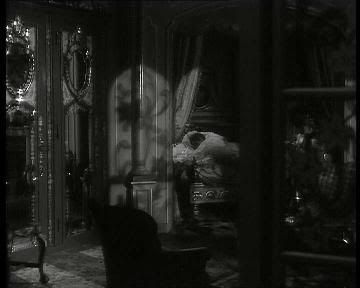

To elucidate the weight of the social obligations placed upon the
haute monde, Ophuls frequently returns to scenes that involve communal gatherings. Lavish balls and operas prove indicative of the trivialities that plague a patrician’s schedule, whilst more serious-minded endeavors such as diplomatic meetings or hunts and duels function primarily as platforms for destruction. The seemingly irreconcilable subjects of fun and death hereby converge to define the director’s near-decadent portrait of elite social structures. True romance’s inability to persevere in such a habitat should therefore come as little surprise. Although its members are readily capable of emotional gravity, Ophuls’s high society is built upon a foundation of hollow joviality that constrains the emergence of feelings as potent as that of love. Hence, its textual absence until the arrival of a relative outsider thirty minutes into the film.
If the suppression of love is an issue for the aristocracy, then it is a problem amplified in the case of its women. With its suggestive title and its creator’s experience,
Madame de… flourishes in the arena of gender politics, and a true to form Ophuls commits himself to imbuing the film’s every frame with an underlying commentary on the veiled sexism of the era. His aims are complemented by a narrative that parallels Louise’s extramarital impulses with that of the General’s, before investigating the ensuing hypocrisy that the contrast generates. Whilst society sanctions the husband’s apparent right to pursue sexual relations with another partner (his mistress, Lola), it simultaneously curbs the desire of the wife, whose genuine love for Donati is denied the opportunity for consummation. This basic inconsistency is key to
Madame de…’s development, for the early revelation of the General’s adultery casts a permanent shadow over Louise and Donati’s romance, acting as a perpetual reminder of the inequality inherent within the marital couple’s partnership.
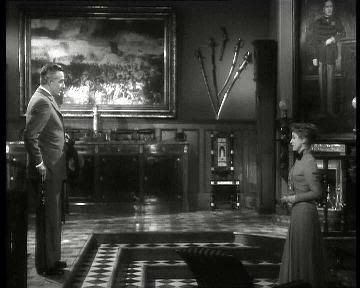
Ophuls’s opulent
mise-en-scène is never more alive than when expanding upon this theme. From the outset, the director instigates a dynamic cinematic correspondence with the viewer that deepens his plot with coded imagery. The lauded opening take of the film lasts for approximately two and a half minutes, and as Louise briskly mulls over her possessions (her debt as yet unknown to us), the camera effortlessly skims around the room with her. In a tantalizing move, Ophuls refuses us an unobstructed view of his heroine for over half of this take, instead opting to interrogate her ornate surroundings - dominated by innumerable jewels, furs and mirrors. When the mystery of Louise’s face is finally revealed to us, she appears not in front of the camera, but as a reflection in one of these dressing-table mirrors. Thus, she is promptly divulged as another constituent in the commodity-infested environment on-screen. Although Louise’s gaze stares back at the audience, her physical presence as the film’s subject is overwhelmed by the multitude of surrounding props, motivating her retreat into objectification. Our perception of the aforementioned commodities thereby undergoes a significant transition: no longer are they mere symbols of wealth and power, they now morph into instruments of covert patriarchal oppression - symptomatic of a “trophy wife” culture that’s adhered to all too fervently. In hindsight then, it is uncomfortably incongruous of Louise to state that
“…I can do as I like with them,” when discussing her valuables this early on. Her chimera of independence is negated by the exact materials that furnish her fantasy.
As if to thwart any lingering doubts that the viewer might have about Ophuls’s thematics, the scenes that immediately follow his bravura introduction conspire to consolidate Louise’s commodification. Over breakfast, she is confronted by a looming portrait of the General that establishes his authority as the archetypal patriarch, not to mention
her diminutive figure in relation to the social order, over five minutes before he makes his first physical appearance in the film. After leaving her home Louise visits a church, in which she visibly arouses the interest of a praying soldier, before reaching her intended destination at a jeweller’s (Monsieur Rémy’s), where she again causes titillation as both the tradesman and his son struggle to contain their own desires. At each of these stages Louise is able to either ignore or spurn the attention showered upon her, but never is she able to entirely reject her elemental status as a receptacle of the male gaze.
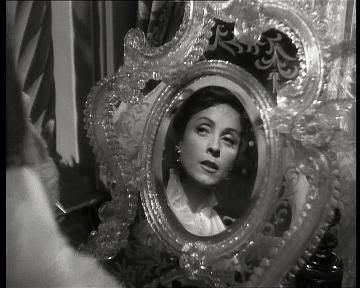
Curiously, for a notable portion of the film Louise actively
revels in this socially-sanctioned role. During the film’s first act she cheerily absorbs male affection and cultivates a reputation as a sort of sophisticated coquette. It is a position that her husband both observes -
“she is adept at making you die of hope” - and accepts:
“A pretty wife is meant to be looked at.” In a context where gender equality is palpably absent, Louise’s simple concessions to her voyeurs enable her to manipulate the prevailing male attitudes of chivalry and lust to a limited extent, thereby granting her a minor but nonetheless important degree of control within her social circle. In spite of this victory, the budding relationship with Donati later in the film provokes Louise to relinquish her privileges in favour of an all-consuming romance:
“I hate society. I want no one to look at me but you.” In actuality, the concept of self-objectification is so ingrained into her mindset that her defiance is rendered a delusion. Louise may attempt to reject collective demands, but by immersing herself so wholly into an individual’s gaze she finds herself entrapped within a different social norm bound by the same stipulation: an existence that is to be defined by her male admirer(s).
Louise is thus incapable of negotiating herself a status greater than that afforded to the possessions that she so cherishes. In essence, she remains another thread in the materialistic drape that blinds the nobility. It is therefore ironic that her life should come to depend so heavily upon the earrings referenced in the film’s (unfortunate) American title. If Louise is exemplary of the patriarchy’s propensity for objectifying its subjects, then the earrings conversely relay its ability to substantiate its objects. Their initial worth is minimal: relics of a marriage contract that each partner treats with merry nonchalance. When Donati miraculously returns them to Louise however, they assume the romantic significance that should arguably have always been assigned to them. It is the discord in personal value between the General’s original gift and Donati’s emotionally-repackaged version of it that triggers the former’s determination to remove them from Louise’s grasp, escalating their price towards even loftier heights. By the finale, they are so value-laden that they undergo a metamorphosis from recreational commodities to religious exhibits. In other words: they become priceless.
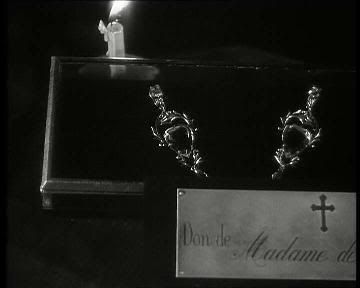
Although the narrative suggests that Louise’s original transaction occurs due to her debts (as well as an implicit need to protect her husband’s prestige), the film’s peculiarly nameless title and the cause-and-effect frameworks that link the earrings to Donati (and therefore, love) hint towards alternative reasoning: a subconscious longing on Louise’s part to escape the confines of her marriage. Standing against her is a patriarchal clasp on
Madame de…’s theatre of exchange that is especially rigid, as demonstrated most clearly by Monsieur Rémy’s consultations with the General. The jeweller’s betrayals of Louise’s misplaced confidence stifle her inadvertent rebellion, administering her passivity in an economic sphere that restricts marketplace activity to men. Meanwhile, Rémy’s visitations to the General’s barracks additionally help to establish a visual association between the military and the return of the earrings, binding the latter to an ultra-masculine order that repeatedly lures them back from their misadventures. It is only her husband’s refusal to re-purchase the jewellery at a critical juncture that allows their escape from this system, meaning that Louise’s triumph over the rules of trade is a virtually empty one. Furthermore, she exchanges almost
all of her valuables to regain the earrings, an act that violates the social codes that her possessions represent. By disregarding
la règle du jeu, Louise sets into motion the chain of events that will drive both her and Donati to their ruin.
This is the cost of forbidden love in Ophuls’s world.
A specific distaste for patriarchal regulations permeates much of the director’s work, and with the evidence thus far one could certainly argue that the trait is most pronounced in
Madame de…. Fortunately, Ophuls is sagacious enough to prevent his art from descending into misandry. The film may condemn the status quo, but it sympathizes with
everyone that it subjugates. Ophuls counterbalances Louise’s woes with the subsequent repression of the men around her, observing that both the General and Donati are suffocated by the very system that endows them with their primacy. That the latter should meet his end thanks to a duel with the former only compounds this issue. Throughout his career the director casts a critical eye upon this socially-acceptable contest of “honour”, though he lambasts the doctrines that permit it rather than the individuals that perform it. This conflict’s victim is perhaps the least interesting member of the film’s romantic triumvirate, but he is also its most important catalyst. It is Donati’s arrival that propels
Madame de… to its giddy highs and its cataclysmic lows, and with his loss both Louise (whose fate becomes entwined with his own) and the film helplessly expire. If his need to look up “desire” in a dictionary and his willingness to terminate relations with the heroine invites the viewer’s suspicions, then his resigned fatalism during the final confrontation scenes emphatically dispels such doubts. When Louise questions him -
“You do no longer love me…?” - Donati’s failure to respond implies that his decision to fight is a harrowingly necessary one: death is now more preferable than the burden of a broken heart.
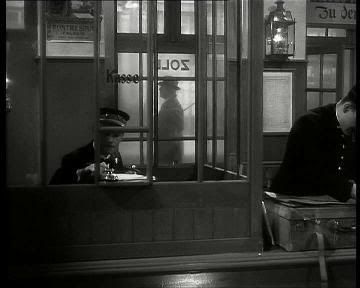

Donati’s murder/suicide further tarnishes the filmic standing of the General, whose effective implementation of social protocols means that of the film’s leads, it is he who veers closest to reprehensibility. However, looks always deceive in an Ophuls picture, and the General is relieved of potential villainy by the director’s careful assertions of his vulnerability. Whilst his breakfast-room portrait that was noted earlier does indeed have a foreboding presence, it is the disparity between role and reality that strikes a chord with the viewer: the charming, urbane and surprisingly short man married to Louise is a far cry from the tall, imposing and authoritative figurehead of the painting. In a much later scene where the General attempts (and fails) to exert this authority by dissuading Louise from leaving Paris, he restlessly begins to shut all the windows in his house. Borrowing a technique from
Le Plaisir, Ophuls shifts perspective by cutting to an
external tracking shot to document this action. The camera’s placement outside the zone of activity allows it to assume the gaze of an extraneous influence at the precise moment when the General locks himself and Louise inside their home. Had the camera been placed
behind him, one could have asserted that the General was in control of this decision to entrap; but by venturing beyond the initial line of vision, Ophuls implicates society for the filmic snare and indicates that this patriarch is as fundamentally enslaved by its conventions as his wife. As he himself poignantly conceded earlier in the film:
“We are not our own masters… especially a general.”This revelatory statement is spoken during the departure scene of his mistress, Lola, and is echoed later on by a near-identical episode with Louise. A comparison of the two incidents unearths the depth of the General’s feeling for his wife. His overall demeanor with Lola is a continuation of the playful ebullience with which he is initially synonymous: he seduces, bids his farewells and exits without once looking back. By contrast, Louise’s departure induces his first visible signs of melancholia, and as her train leaves he gazes forlornly at the mechanisms that pull his wife away from him. In another of the film’s many ironies, it is Lola who receives the farewell kiss on the lips, with Louise settling for an unnervingly formal peck on the hand. The General’s superficial lifestyle and his adherence to militaristic codes have paralyzed his confidence in genuine matters of the heart. Of all the characters in the film, it is he who suffers the greatest divergence between their public and personal identities.

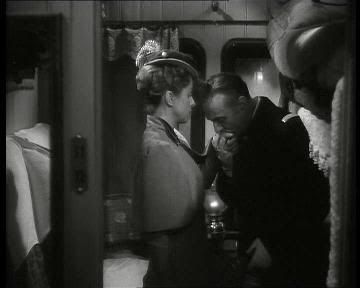 Madame de…
Madame de…’s great tragedy then, is that
all of its leads experience an epiphany during the course of the film. Take Ophuls’s euphorically informative visuals out of the equation and they begin, on paper at least, as shallow and careless individuals, content to wallow endlessly in their merry masquerades. As their character trajectories progress however, each of them undergoes a radical change. The introduction of passion into the narrative engenders a process of humanization that coincides with an increasing awareness of their desires. Unfortunately for them, these desires also unravel their orderly lives, heightening the need to restore the frivolous standard and imprisoning them within roles that they no longer wish to play. And with the comings and goings of the earrings constantly sculpting the film’s emotional panorama, one begins to comprehend just how irrevocable society’s materialism really is.
Materialist ethics go so far as to infiltrate the domain of the spiritual.
“My cross?”, says Louise in the opening scene when evaluating her possessions,
“Oh no, I adore it!” Her actions in the film affiliate religion with the prevalent world of transactions, but neither she nor Ophuls ever lose sight of its intensely personal value. Towards the end of the film, Louise visits a church and begs a saint to accept her treasured earrings as a suitable exchange for Donati’s safety. The saint’s apparent “refusal” to enter into this bargain says less about the absence of the divine than it does about the worth of life itself. Ophuls uses Louise’s act of desperation to delineate between the institution of the Church and the integrity of private faith: it is the former that accepts the gift and presents them in their most fetishized form at film’s end; it is the
latter that reassigns the ethereal relevance entrusted to the earrings unto Donati’s existence. The celestial powers-that-be thus reveal themselves as the only abstract forces in the film that esteem the invaluable beauty of the human spirit over the metallic perfection of the earrings. In freeing Donati and consequently Louise from the shackles of society, it could be argued that the saint does, in actuality, grant her wish. The film’s seemingly tragic finale allows the couple to relocate their love to the only realm in which it can possibly survive: the afterlife.
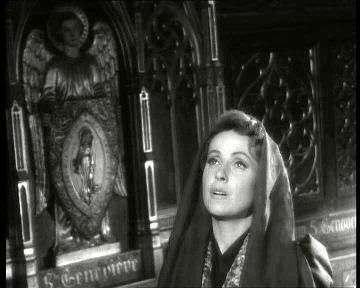
There is a sequence in
Madame de… whose reputation is nearly as great as the film’s own. It can be summarized as a dance between Donati and Louise, but to describe it as such seems a woeful miscarriage of justice. It is more akin to an elegant roundelay of passion, charged with all the urgency of repressed desire. As the two admirers waltz, the director’s camera seamlessly cuts and dissolves around them, layering emotional subtexts onto one another and completely disregarding time whilst remaining all too aware of the threat that it poses. The cumulative effect of all this is overwhelming, compelling the audience to surrender themselves to the impeccably crafted-insularity of the burgeoning love that saturates the frame.
It is this enchanting sequence that best encapsulates the spirit of Ophuls’s magnificent art. Supported by his camera’s graceful choreography, the director concisely articulates the importance of pure sentiment in environments where they are consistently marginalized. Moreover, he excels in charting the progression of such feelings: during a five-minute ballroom routine Ophuls can leap at will from formality to informality, from vacuity to cognizance, and most importantly from frivolity to love. For this artist, such oppositions work in symbiosis to enrich the texture of his films, and his penultimate effort exemplifies these contradictions at their finest. It enamours with its celebration of the superficial, only to take apart its own convivial artifice once the viewer is on side. When its masquerade is eventually unclothed, there lies a film that exalts love as the greatest emotion that one could ever know. In denying this joy to the characters with whom it is so acutely attuned,
Madame de… proves itself to be the most cynical of all cinema’s great romances.

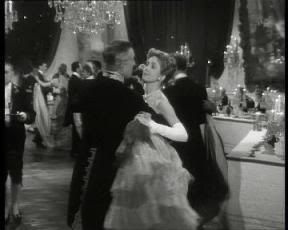

 An unsettling sense of disconnect permeates The Ascent (1977). Further scrutiny reveals a surprising source for the phenomenon: a simple segregation of black and white. Its first half is situated almost entirely in snow-smothered Belarus, where high-contrast photography figuratively exposes the two divergent strands of morality that will come to dominate the film's psychological canvas. In these initial chapters, Larisa Shepitko shows few qualms in pursuing a partisan approach to her subject matter: this is World War II, where the Soviet populace struggle to survive alongside the malevolent spectre of their German tormentors. It certainly appears as if the director's aesthetics are being used to sculpt a patriotic tale of good vs. evil.
An unsettling sense of disconnect permeates The Ascent (1977). Further scrutiny reveals a surprising source for the phenomenon: a simple segregation of black and white. Its first half is situated almost entirely in snow-smothered Belarus, where high-contrast photography figuratively exposes the two divergent strands of morality that will come to dominate the film's psychological canvas. In these initial chapters, Larisa Shepitko shows few qualms in pursuing a partisan approach to her subject matter: this is World War II, where the Soviet populace struggle to survive alongside the malevolent spectre of their German tormentors. It certainly appears as if the director's aesthetics are being used to sculpt a patriotic tale of good vs. evil.
 The Ascent is most alive when exploring the expanses offered by the Belarussian countryside, in which it discovers a brand of lyrical realism that intoxicates the senses. Nevertheless, the film's greatest gift is also its biggest flaw. Shepitko's visual style is ravishing to the point where its absence during the confined spaces of the film's second half is felt all too resolutely by the viewer. Undoubtedly, this is her intent; the transition from agoraphobia to claustrophobia inducing a dissonance that reinforces the inhumanity of the protagonists' incarceration. Yet in opting for such a technique, the director strips away at the imagery that grounds her shamelessly allegorical narrative in authenticity. Without the open spaces in which her camera thrives, The Ascent begins to sag under the weight of its Christian metaphors: this is, in essence, a 20th-century reconceptualization of the Jesus/Judas relationship. Jesus (Sotnikov) is venerated beyond belief, whilst Judas (Rybak) exchanges his integrity for survival - degenerating into delusional paranoia as a result. Has Shepitko therefore duped us? Are her attempts to comprehend the individual/national conscience merely a disguise for yet another dualism (hero vs. villain), this time with a Biblical twist?
The Ascent is most alive when exploring the expanses offered by the Belarussian countryside, in which it discovers a brand of lyrical realism that intoxicates the senses. Nevertheless, the film's greatest gift is also its biggest flaw. Shepitko's visual style is ravishing to the point where its absence during the confined spaces of the film's second half is felt all too resolutely by the viewer. Undoubtedly, this is her intent; the transition from agoraphobia to claustrophobia inducing a dissonance that reinforces the inhumanity of the protagonists' incarceration. Yet in opting for such a technique, the director strips away at the imagery that grounds her shamelessly allegorical narrative in authenticity. Without the open spaces in which her camera thrives, The Ascent begins to sag under the weight of its Christian metaphors: this is, in essence, a 20th-century reconceptualization of the Jesus/Judas relationship. Jesus (Sotnikov) is venerated beyond belief, whilst Judas (Rybak) exchanges his integrity for survival - degenerating into delusional paranoia as a result. Has Shepitko therefore duped us? Are her attempts to comprehend the individual/national conscience merely a disguise for yet another dualism (hero vs. villain), this time with a Biblical twist?